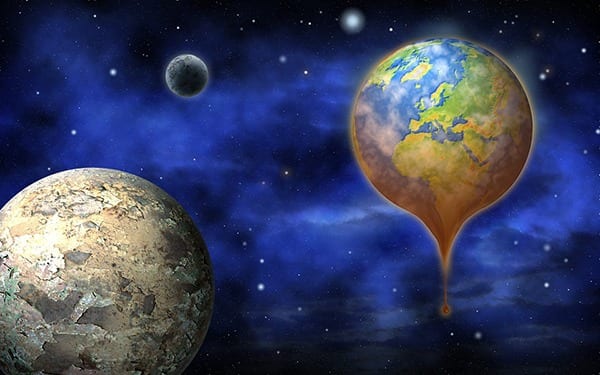
Harmony Unraveled: Navigating Earth’s Energy Balance Amidst Climate Change
Updated Dec 15, 2023
Introduction
The Earth’s energy balance, an intricate dance between incoming and outgoing energy, fundamentally shapes our planet’s climate. This exchange governs our everyday weather patterns, long-term climate phenomena, and the potential for future climate change. One fact stands out among the complexities of this balance: nearly 30% of the energy that reaches our blue-green planet is reflected back into the vast expanse of outer space. Understanding this phenomenon helps us comprehend the ongoing changes in our climate.
The Sun’s Energy: A Critical Balancing Act
Our Earth, a vibrant sphere teeming with life, is nourished by a ceaseless stream of energy from a celestial body 93 million miles away: the Sun. This blazing ball of hot plasma, an incandescent sphere of unparalleled power, serves as the life force for our planet. It shows us a staggering 174 petawatts of solar energy daily, a figure so colossal that it boggles the mind.
This solar energy reaches us through sunlight and is the primary driver of the Earth’s energy balance. The unseen hand sculpts our climate, shapes our weather, and, in essence, fuels life as we know it. The energy is absorbed, reflected, and redistributed in a complex dance that profoundly influences our planet’s climate and local weather patterns.
The Earth absorbs about 70% of the incoming solar energy, which fuels photosynthesis, drives the water cycle, and warms the surface. The remaining 30% is reflected in space, a natural mechanism that prevents our planet from overheating. This delicate equilibrium, this intricate balancing act, maintains the Earth’s average temperature around a life-supporting 15 degrees Celsius.
However, this delicate balance is being disrupted like a perfectly tuned orchestra thrown into discord by a single false note. Human activities, primarily burning fossil fuels and rampant deforestation, are tipping the scales towards an energy imbalance. This is leading to an unprecedented and accelerated rate of climate change.
The Intergovernmental Panel on Climate Change (IPCC) reports a more than 40% increase in total radiative forcing – the balance between incoming and outgoing energy in the Earth’s climate system – from 1990 to 2020 due to human activities. This has increased global average temperatures, with the last decade being the hottest on record.
This human-induced climate change is not a distant threat but a reality we are grappling with today. It is a disruption of the critical balancing act that has maintained the Earth’s livable climate since immemorial.
As we delve deeper into Earth’s energy balance complexities, we find ourselves standing on the precipice of a new understanding. A comprehension of our place within the vast cosmic order and our ability to influence it. This understanding brings with it a sense of responsibility. The power to tip the scales of Earth’s energy balance lies within our hands. The question is: can we restore the balance before it’s too late?
.
The Greenhouse Effect: A Double-Edged Sword
The greenhouse effect, a natural process that warms the Earth’s surface, plays a crucial role in preserving life on our planet. However, human-induced increases in greenhouse gases such as carbon dioxide and methane heighten this effect, leading to global warming and climate change. These changes have far-reaching consequences, from melting polar ice caps to more frequent and severe weather events.
The Earth’s albedo, a measure of its reflectivity, is a significant player in the energy balance. Surfaces with high albedo, like ice caps, reflect a substantial amount of solar radiation into space, helping to cool the planet. In contrast, surfaces with low albedo, such as oceans and forests, absorb more solar energy, contributing to global warming.
The Greenhouse Effect: A Double-Edged Sword
The greenhouse effect, a natural process that warms the Earth’s surface, is vital to our planet’s climate system. It’s akin to a protective blanket around the Earth, trapping some of the Sun’s heat and preventing it from escaping back into space. This process is essential for life, maintaining the Earth’s average temperature at a comfortable 15 degrees Celsius, perfect for the flourishing of life as we know it.
However, this beneficial process has a darker side when amplified by human activities. Burning fossil fuels and deforestation have led to an increase in greenhouse gases such as carbon dioxide and methane in the atmosphere. These gases trap more heat, enhancing the greenhouse effect and leading to global warming.
The Intergovernmental Panel on Climate Change (IPCC) reports that the total radiative forcing, the difference between sunlight absorbed by the Earth and energy radiated back into space, has increased more than 40% between 1990 and 2020 due to human activities. This has increased global average temperatures, with the last decade being the hottest on record.
The consequences of this enhanced greenhouse effect are far-reaching and alarming. Melting polar ice caps, rising sea levels, more frequent and severe weather events, and disruptions to ecosystems and agriculture are just a few of the impacts we’re already experiencing.
The Earth’s Albedo: A Significant Player in the Energy Balance
The Earth’s albedo, a measure of its reflectivity, is another significant player in the energy balance. It’s like the Earth’s mirror, reflecting solar radiation back into space. Surfaces with high albedo, like the ice caps and clouds, reflect substantial solar radiation, helping to cool the planet.
However, surfaces with low albedo, such as oceans and forests, absorb more solar energy, contributing to global warming. Changes in land use, such as deforestation and urbanization, are reducing the Earth’s overall albedo, leading to more absorption of solar energy and further warming.
Moreover, melting ice caps due to global warming is reducing the Earth’s albedo, as ice and snow have a higher albedo than water or land. This creates a feedback loop, where warming leads to melting ice, which reduces albedo and leads to more warming.
Climate Change Mitigation: The Role of Albedo Modification
In the face of the relentless march of climate change, scientists are exploring innovative and sometimes controversial ways to mitigate its impacts. One such strategy is albedo modification, a concept that sounds straight out of a science fiction novel. The idea is to artificially increase the Earth’s reflectivity, reflecting more sunlight into space and cooling the planet.
Albedo modification techniques are as fascinating as they are diverse. One proposed method involves dispersing reflective particles or aerosols into the upper atmosphere. These particles would scatter sunlight, reducing the amount of solar energy reaching the Earth’s surface. Another approach, known as marine cloud brightening, involves injecting tiny salt particles into low-lying clouds over the ocean. The salt particles would make the clouds more reflective, increasing their albedo and causing them to reflect more sunlight into space.
These techniques, while promising, are not without their challenges. They are akin to applying a band-aid to a deep wound; they may offer temporary relief from the symptoms of climate change, but they do not address the root cause—excessive greenhouse gas emissions. Moreover, they come with potential risks and uncertainties. The long-term consequences of such interventions are still not fully understood, and ethical and environmental concerns must be considered.
For instance, while increasing the Earth’s albedo could help cool the planet, it could also disrupt weather patterns, potentially causing droughts in some regions and floods in others. There are also concerns about the impact on the ozone layer and the potential for international conflict over such technologies.
Despite these challenges, the potential of albedo modification techniques to help mitigate climate change cannot be ignored. They represent a powerful tool in our arsenal against global warming that could buy us valuable time as we work to reduce greenhouse gas emissions and transition to a more sustainable future.
However, it’s important to remember that albedo modification is not a silver bullet. It’s a potential part of the solution but cannot replace the need to reduce greenhouse gas emissions. The most effective way to combat climate change is to reduce our carbon footprint, transition to renewable energy sources, and adopt more sustainable lifestyles.
As we continue to explore and develop these innovative strategies, we must also continue to focus on the root cause of climate change. We hope to achieve a sustainable balance in the Earth’s energy system by addressing our greenhouse gas emissions and securing a safe and stable climate for future generations.
The Imperative of Climate Policies and Individual Actions
In the grand theatre of climate change, where the stakes are nothing less than the future of our planet, the role of climate policies and individual actions cannot be overstated. The battle against this global challenge is fought on many fronts, and it requires a symphony of efforts, from the sweeping measures of international agreements to the everyday choices of individuals.
**Climate policies** are the frameworks and strategies nations adopt to tackle the root causes of climate change. They are the blueprints for a sustainable future, guiding us towards reducing greenhouse gas emissions, transitioning to renewable energy sources, and protecting our forests’ natural carbon sinks. These policies are not just political statements but commitments to action, reflecting our collective resolve to forge a path to a low-carbon economy.
The success of these policies hinges on their ability to mobilize capital, foster innovation, and drive systemic changes across industries and societies. They are designed to catalyze a shift in how we produce and consume energy, manage land, and conduct our lives. The financial services industry, for instance, plays a pivotal role by directing investments towards sustainable initiatives, with climate finance flows exceeding significant figures in recent years.
On the other hand, individual actions are the personal choices and behaviours that contribute to the fight against climate change. These actions range from reducing energy consumption and minimizing waste to supporting environmentally friendly initiatives and adopting sustainable lifestyles. Each choice, no matter how small, creates a significant impact. When individuals embrace sustainable practices, they reduce their carbon footprint and inspire others to follow suit, creating a ripple effect that can transform communities and, ultimately, the world.
The interplay between climate policies and individual actions is a dance of mutual reinforcement. Policies can empower individuals by providing the infrastructure and incentives for sustainable living, while the collective demand from individuals can drive policymakers to enact bolder, more ambitious climate strategies. This synergy is crucial for balancing managing albedo and curbing greenhouse gas emissions, two essential components in combatting climate change effectively.
Our actions today are the seeds of tomorrow’s reality. They are the brushstrokes in the portrait of our planet’s future. By working collectively towards a sustainable future, we are not just preserving the Earth for future generations; we are also upholding the principles of equity and justice, ensuring that the benefits of a healthier planet are shared by all, especially those on the frontlines of climate change.
The imperative of climate policies and individual actions is clear: they are the twin engines driving us towards a more resilient and sustainable world. As we navigate the complexities of climate change, let us remember that our choices and actions are powerful. They can shape our planet’s future, ensure that the Earth’s energy balance remains in harmony, and safeguard the delicate symphony of life that thrives on our unique and precious world.
Final Thoughts: The Indelible Link Between Earth’s Energy Balance and Climate Change
In our world today, the shadow of climate change looms large. As we grapple with rising temperatures, erratic weather patterns, and the cascading effects of a shifting climate, it’s evident that understanding the Earth’s energy dynamics is not merely an academic exercise. It is a compelling necessity, a key to unlocking solutions to the most pressing challenge of our time.
The 30% reflection of energy into outer space, a seemingly obscure scientific detail, is a fundamental piece of the climate change jigsaw. It’s a testament to the intricate balance that has maintained the Earth’s habitable climate for billions of years. Yet, this balance is at risk, and the resulting climate change is a stark reminder of the interconnectedness of Earth’s systems and the profound impact of human activities.
As we delve deeper into the Earth’s energy balance complexities, we uncover a story of cause and effect, where today’s actions shape the world of tomorrow. We see that our choices, from the energy we use to the food we eat, can tip the scales of this delicate balance, driving climate change and its impacts.
But this story is not one of despair. It’s a story of opportunity, of potential, and of hope. By striving to understand the impacts of global warming and by taking decisive action to address it, we have the power to write a new chapter in this story. We can rebalance the scales, restore the harmony of the Earth’s energy system, and pave the way for a sustainable future.
The challenge of climate change is immense, but so is our capacity for innovation, adaptation, and change. As we stand at the crossroads, our path will determine the legacy we leave for generations. Let us choose the path of understanding, of action, and resilience. Let us choose a path that respects the indelible link between Earth’s energy balance and climate change and strives to safeguard our precious planet for the many generations yet to come.
Other Articles of Interest
EU stands to benefit by Granting China free market status
China cuts rates to boost green energy demand

China showcases its culture to the World
Remaking Moscow lures more Chinese investment
Chinese firms extend Moscow’s rail networks
Russians show patriotism on nuclear bunker tours
Moscow hi-tech parks seek lower production costs
Despite challenges & sanctions: Russian oil & gas remain profitable
Downed Su-24 shows U.S treachery
Global Warming Is Fake: Let’s See If This is True

Chinese flocking to U.S. Real Estate and German Migrant crisis

U.S. backed Coup in Ukraine, China wins, Russia resists



